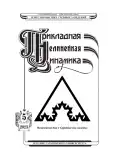Mathematical model of the photoplethysmogram for testing methods of biological signals analysis
- Authors: Vakhlaeva A.M.1, Ishbulatov Y.M.1, Karavaev A.S.1,2,3, Ponomarenko V.I.2, Prokhorov M.D.2
-
Affiliations:
- Saratov State University
- Saratov Branch of Kotel`nikov Institute of Radiophysics and Electronics of Russian Academy of Sciences
- Saratov State Medical University named after V. I. Razumovsky
- Issue: Vol 31, No 5 (2023)
- Pages: 586-596
- Section: Articles
- URL: https://journals.rcsi.science/0869-6632/article/view/251290
- DOI: https://doi.org/10.18500/0869-6632-003059
- EDN: https://elibrary.ru/WGKVOM
- ID: 251290
Cite item
Full Text
Abstract
About the authors
Anna Mikhailovna Vakhlaeva
Saratov State Universityul. Astrakhanskaya, 83, Saratov, 410012, Russia
Yuri Michailovich Ishbulatov
Saratov State University
ORCID iD: 0000-0003-2871-5465
Scopus Author ID: 57160264200
ResearcherId: I-1506-2016
ul. Astrakhanskaya, 83, Saratov, 410012, Russia
Anatolij Sergeevich Karavaev
Saratov State University; Saratov Branch of Kotel`nikov Institute of Radiophysics and Electronics of Russian Academy of Sciences; Saratov State Medical University named after V. I. Razumovsky
ORCID iD: 0000-0003-4678-3648
SPIN-code: 10808548
Scopus Author ID: 7003666161
ResearcherId: D-8137-2013
ul. Astrakhanskaya, 83, Saratov, 410012, Russia
Vladimir Ivanovich Ponomarenko
Saratov Branch of Kotel`nikov Institute of Radiophysics and Electronics of Russian Academy of Sciences
ORCID iD: 0000-0002-1579-6465
Scopus Author ID: 35613865300
ResearcherId: H-2602-2012
ul. Zelyonaya, 38, Saratov, 410019, Russia
Mihail Dmitrievich Prokhorov
Saratov Branch of Kotel`nikov Institute of Radiophysics and Electronics of Russian Academy of Sciences
ORCID iD: 0000-0003-4069-9410
ul. Zelyonaya, 38, Saratov, 410019, Russia
References
- Gorshkov O, Ombao H. Multi-chaotic analysis of inter-beat (R-R) intervals in cardiac signals for discrimination between normal and pathological classes. Entropy (Basel). 2021;23(1):112. doi: 10.3390/e23010112.
- Fagard RH, Stolarz K, Kuznetsova T, Seidlerova J, Tikhonoff V, Grodzicki T, Nikitin Y, Filipovsky J, Peleska J, Casiglia E, Thijs L, Staessen JA, Kawecka-Jaszcz K. Sympathetic activity, assessed by power spectral analysis of heart rate variability, in white-coat, masked and sustained hypertension versus true normotension. J. Hypertens. 2007;25(11):2280–2285. doi: 10.1097/HJH.0b013e3282efc1fe.
- Borovkova EI, Prokhorov MD, Kiselev AR, Hramkov AN, Mironov SA, Agaltsov MV, Ponomarenko VI, Karavaev AS, Drapkina OM, Penzel T. Directional couplings between the respiration and parasympathetic control of the heart rate during sleep and wakefulness in healthy subjects at different ages. Front. Netw. Physiol. 2022;2:942700. doi: 10.3389/fnetp.2022.942700.
- Ponomarenko VI, Prokhorov MD, Karavaev AS, Kiselev AR, Gridnev VI, Bezruchko BP. Synchronization of low-frequency oscillations in the cardiovascular system: Application to medical diagnostics and treatment. The European Physical Journal Special Topics. 2013;222(10): 2687–2696. doi: 10.1140/epjst/e2013-02048-1.
- Lefrandt JD, Smit AJ, Zeebregts CJ, Gans ROB, Hoogenberg KH. Autonomic dysfunction in diabetes: a consequence of cardiovascular damage. Current Diabetes Reviews. 2010;6(6):348–358. doi: 10.2174/157339910793499128.
- Dimitriev DA, Saperova EV, Dimitriev AD. State anxiety and nonlinear dynamics of heart rate variability in students. PLoS ONE. 2016;11(1):e0146131. doi: 10.1371/journal.pone.0146131.
- Deka B, Deka D. Nonlinear analysis of heart rate variability signals in meditative state: a review and perspective. BioMedical Engineering OnLine. 2023;22(1):35. doi: 10.1186/s12938-023- 01100-3.
- de Abreu RM, Porta A, Rehder-Santos P, Cairo B, Sakaguchi CA, da Silva CD, Signini EF, Milan-Mattos JC, Catai AM. Cardiorespiratory coupling strength in athletes and non-athletes. Respiratory Physiology & Neurobiology. 2022;305:103943. doi: 10.1016/j.resp.2022.103943.
- Delliaux S, Ichinose M, Watanabe K, Fujii N, Nishiyasu T. Muscle metaboreflex activation during hypercapnia modifies nonlinear heart rhythm dynamics, increasing the complexity of the sinus node autonomic regulation in humans. Pflugers Archiv - European Journal of Physiology. 2023;475(4):527–539. doi: 10.1007/s00424-022-02780-x.
- Karavaev AS, Skazkina VV, Borovkova EI, Prokhorov MD, Hramkov AN, Ponomarenko VI, Runnova AE, Gridnev VI, Kiselev AR, Kuznetsov NV, Chechurin LS, Penzel T. Synchronization of the processes of autonomic control of blood circulation in humans is different in the awake state and in sleep stages. Front. Neurosci. 2022;15:791510. doi: 10.3389/fnins.2021.791510.
- Goldstein DS, Bentho O, Park MY, Sharabi Y. Low-frequency power of heart rate variability is not a measure of cardiac sympathetic tone but may be a measure of modulation of cardiac autonomic outflows by baroreflexes. Exp. Physiol. 2011;96(12):1255–1261. doi: 10.1113/expphysiol. 2010.056259.
- Natarajan A, Pantelopoulos A, Emir-Farinas H, Natarajan P. Heart rate variability with photoplethys-mography in 8 million individuals: a cross-sectional study. The Lancet Digital Health. 2020;2(12): E650–E657. doi: 10.1016/S2589-7500(20)30246-6.
- Ringwood JV, Malpas SC. Slow oscillations in blood pressure via a nonlinear feedback model. American Journal of Physiology-Regulatory, Integrative and Comparative Physiology. 2001;280(4): R1105–R1115. doi: 10.1152/ajpregu.2001.280.4.R1105.
- Tang Q, Chen Z, Ward R, Elgendi M. Synthetic photoplethysmogram generation using two Gaussian functions. Sci. Rep. 2020;10(1):13883. doi: 10.1038/s41598-020-69076-x.
- McSharry PE, Clifford GD, Tarassenko L, Smith LA. A dynamical model for generating synthetic electrocardiogram signals. IEEE Transactions on Biomedical Engineering. 2003;50(3):289–294. doi: 10.1109/TBME.2003.808805.
- Cheng L, Khoo MCK. Modeling the autonomic and metabolic effects of obstructive sleep apnea: a simulation study. Front. Physiol. 2012;2:111. doi: 10.3389/fphys.2011.00111.
- Mejıa-Mejıa E, May JM, Torres R, Kyriacou PA. Pulse rate variability in cardiovascular health: a review on its applications and relationship with heart rate variability. Physiol. Meas. 2020;41(7):07TR01. doi: 10.1088/1361-6579/ab998c.
- Kotani K, Struzik ZR, Takamasu K, Stanley HE, Yamamoto Y. Model for complex heart rate dynamics in health and diseases. Phys. Rev. E. 2005;72(4):041904. doi: 10.1103/PhysRevE. 72.041904.
Supplementary files










